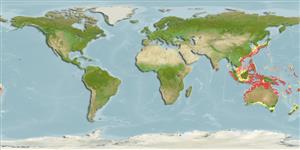Classification / Names
Common names | Synonyms | Catalog of Fishes (gen., sp.) | ITIS | CoL | WoRMS | Cloffa
Environment / Climate / Range
Ecology
Marine; brackish; reef-associated; depth range 3 - 100 m (Ref. 9710). Tropical, preferred ?
Western Pacific: central Honshu, Japan to Taiwan and the Philippines. Also occurs in Indonesia and northwestern Australia, a new record for the northeastern Indian Ocean (Ref. 5978).
Size / Weight / Age
Maturity: Lm ? range ? - ? cm
Max length : 12.0 cm TL male/unsexed; (Ref. 559); common length : 8.0 cm TL male/unsexed; (Ref. 9137)
May enter semi-enclosed sea areas; forms schools over rocky bottoms (Ref. 11230). Nocturnal species (Ref. 7300). Breeding pairs are found from July to September in Japan. Mouth brooding is done by the male (Ref. 240).
Life cycle and mating behavior
Maturity | Reproduction | Spawning | Eggs | Fecundity | Larvae
Mouthbrooders (Ref. 240). Distinct pairing during courtship and spawning (Ref. 205). Displays obligate monogamy where a one-to-one pair is established irrespective of resource abundance (Ref. 52884).
Masuda, H., K. Amaoka, C. Araga, T. Uyeno and T. Yoshino, 1984. The fishes of the Japanese Archipelago. Vol. 1. Tokai University Press, Tokyo, Japan. 437 p. (text). (Ref. 559)
IUCN Red List Status (Ref. 115185)
CITES (Ref. 94142)
Not Evaluated
Threat to humans
Harmless
Human uses
Fisheries: subsistence fisheries
More information
ReferencesAquacultureAquaculture profileStrainsGeneticsAllele frequenciesHeritabilityDiseasesProcessingMass conversion
Tools
Special reports
Download XML
Internet sources
